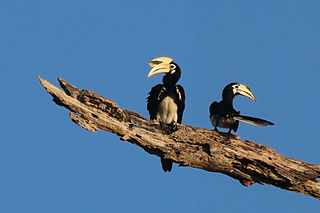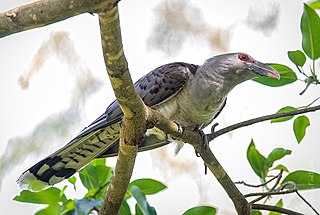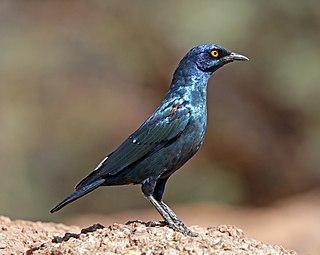
The fieldfare is a member of the thrush family Turdidae. It breeds in woodland and scrub in northern Europe and across the Palearctic. It is strongly migratory, with many northern birds moving south during the winter. It is a very rare breeder in Great Britain & Ireland, but winters in large numbers in the United Kingdom, Southern Europe, North Africa and the Middle East. It is omnivorous, eating a wide range of molluscs, insects and earthworms in the summer, and berries, grain and seeds in the winter.

The great spotted woodpecker is a medium-sized woodpecker with pied black and white plumage and a red patch on the lower belly. Males and young birds also have red markings on the neck or head. This species is found across the Palearctic including parts of North Africa. Across most of its range it is resident, but in the north some will migrate if the conifer cone crop fails. Some individuals have a tendency to wander, leading to the recent recolonisation of Ireland and to vagrancy to North America. Great spotted woodpeckers chisel into trees to find food or excavate nest holes, and also drum for contact and territorial advertisement; like other woodpeckers, they have anatomical adaptations to manage the physical stresses from the hammering action. This species is similar to the Syrian woodpecker.

The pied currawong is a black passerine bird native to eastern Australia and Lord Howe Island. One of three currawong species in the genus Strepera, it is closely related to the butcherbirds and Australian magpie of the family Artamidae. Six subspecies are recognised. It is a robust crowlike bird averaging around 48 cm (19 in) in length, black or sooty grey-black in plumage with white undertail and wing patches, yellow irises, and a heavy bill. The male and female are similar in appearance. Known for its melodious calls, the species' name currawong is believed to be of indigenous origin.

Starlings are small to medium-sized passerine birds in the family Sturnidae. The name "Sturnidae" comes from the Latin word for starling, sturnus. Many Asian species, particularly the larger ones, are called mynas, and many African species are known as glossy starlings because of their iridescent plumage. Starlings are native to Europe, Asia and Africa, as well as northern Australia and the islands of the tropical Pacific. Several European and Asian species have been introduced to these areas as well as North America, Hawaii and New Zealand, where they generally compete for habitats with native birds and are considered to be invasive species. The starling species familiar to most people in Europe and North America is the common starling, and throughout much of Asia and the Pacific, the common myna is indeed common.

The bronze mannikin or bronze munia is a small passerine bird of the Afrotropics. This very social estrildid finch is an uncommon to locally abundant bird in much of Africa south of the Sahara Desert, where it is resident, nomadic or irruptive in mesic savanna or forest margin habitats. It has an estimated global extent of occurrence of 8,100,000 km2. It is the smallest and most widespread of four munia species on the African mainland, the other being black-and-white, red-backed and magpie mannikin. It co-occurs with the Madagascar mannikin on the Comoro Islands, and was introduced to Puerto Rico. Especially in the West Africa, it is considered a pest in grain and rice fields. It is locally trapped for the pet bird trade.

The black skimmer is a tern-like seabird, one of three similar birds species in the skimmer genus Rynchops in the gull family Laridae. It breeds in North and South America. Northern populations winter in the warmer waters of the Caribbean and the tropical and subtropical Pacific coasts, but the South American races make only shorter movements in response to annual floods which extend their feeding areas in the river shallows.

The superb starling is a member of the starling family of birds. It was formerly known as Spreo superbus.

The golden-breasted starling, also known as royal starling, is a medium-sized passerine in the starling family.

The white-headed buffalo weaver or white-faced buffalo-weaver is a species of passerine bird in the family Ploceidae native to East Africa. The buffalo part of its name derives from its habit of following the African buffalo, feeding on disturbed insects. Two subspecies are recognized.

Lamprotornis is a large genus of glossy-starlings all of which occur in Africa south of the Sahara. They have glossy blue or green upper parts, which is due to hollow melanin granules arranged in a single layer near the feather barbule's surface. This unique arrangement led to some glossy starlings formerly placed in the genus Spreo being transferred to Lamprotornis, since they shared this feature.

The red-winged starling is a bird of the starling family Sturnidae native to eastern Africa from Ethiopia to the Cape in South Africa. An omnivorous, generalist species, it prefers cliffs and mountainous areas for nesting, and has moved into cities and towns due to similarity to its original habitat.

The emerald starling is also known as the iris glossy starling. It is a small starling with a metallic green crown, upper body, wings and tail. The ear-coverts and underparts are metallic purple. Both sexes are similar. Most taxonomists unite it with many other glossy starlings in Lamprotornis, while others place it in a monotypic genus Coccycolius.

Fischer's starling is a bird which is an uncommon resident breeder from southern Ethiopia and Somalia to eastern Kenya and Tanzania. It is found in dry open acacia thornbush.

The wattled starling is a nomadic resident bird in eastern and southern Africa. It is a species of grassland, open woodland, and cultivation.

The greater blue-eared starling or greater blue-eared glossy-starling is a bird that breeds from Senegal east to Ethiopia and south through eastern Africa to northeastern South Africa and Angola. It is a very common species of open woodland bird, and undertakes some seasonal migration.

The oriental pied hornbill is an Indo-Malayan pied hornbill, a large canopy-dwelling bird belonging to the family Bucerotidae. Two other common names for this species are Sunda pied hornbill (convexus) and Malaysian pied hornbill.

The channel-billed cuckoo is a species of cuckoo in the family Cuculidae. It is monotypic within the genus Scythrops. The species is the largest brood parasite in the world, and the largest cuckoo.

Hildebrandt's starling is a species of starling in the family Sturnidae. It forms a superspecies with and has previously been included in the same species as Shelley's starling, a migratory species ranging from Ethiopia and Somalia to Kenya. Both of these species have also been combined into a superspecies with the chestnut-bellied starling of West Africa. It was originally placed in the now defunct genus Notauges. The species is named for Johann Maria Hildebrandt, a German collector who was the first European to obtain specimens.

The Cape starling, also known as red-shouldered glossy-starling or Cape glossy starling, is a species of starling in the family Sturnidae. It is found in Southern Africa, where it lives in woodlands, bushveld and in suburbs.

The swamp boubou, also known as the Gabon boubou, is a species of bird in the Malaconotidae or bushshrike family. It is native to western and southern Central Africa. In the north of their range, savannah thickets constitute an important part of their habitat, while in the south they are strongly associated with river systems and marshes, for which they are named. The pair bond appears to be maintained by duetting, which in the south is generally synchronous or overlapping. It is most similar to L. major major, with which it perhaps hybridizes, but the underpart plumage is immaculate white, while the female contributes a ratchet-like note to the duet.






















